Cellular heterogeneity and key subsets of tissue-resident memory T cells in cervical cancer
- PMID: 39014148
- PMCID: PMC11252146
- DOI: 10.1038/s41698-024-00637-3
Cellular heterogeneity and key subsets of tissue-resident memory T cells in cervical cancer
Abstract
Tissue-resident memory T cells (TRMs) play a critical role in cancer immunity by offering quick and effective immune responses. However, the cellular heterogeneity of TRMs and their significance in cervical cancer (CC) remain unknown. In this study, we generated and analyzed single-cell RNA sequencing data from 12,945 TRMs (ITGAE+ CD3D+) and 25,627 non-TRMs (ITGAE- CD3D+), derived from 11 CC tissues and 5 normal cervical tissues. We found that TRMs were more immunoreactive than non-TRMs, and TRMs in CC tissues were more activated than those in normal cervical tissues. Six CD8+ TRM subclusters and one CD4+ TRM subcluster were identified. Among them, CXCL13+ CD8+ TRMs were more abundant in CC tissues than in normal cervical tissues, had both cytotoxic and inhibitory features, and were enriched in pathways related to defense responses to the virus. Meanwhile, PLAC8+ CD8+ TRMs were less abundant in CC tissues than in normal cervical tissues but had highly cytotoxic features. The signature gene set scores of both cell subclusters were positively correlated with the overall survival and progression-free survival of patients with CC following radiotherapy. Of note, the association between HLA-E and NKG2A, either alone or in a complex with CD94, was enriched in CXCL13+ CD8+ TRMs interacting with epithelial cells at CC tissues. The in-depth characterization of TRMs heterogeneity in the microenvironment of CC could have important implications for advancing treatment and improving the prognosis of patients with CC.
© 2024. The Author(s).
Conflict of interest statement
The authors declare no competing interests.
Figures
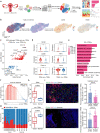
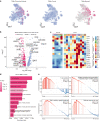
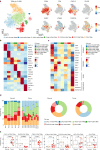
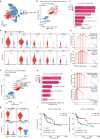
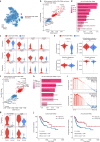
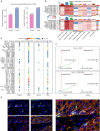
Similar articles
-
Hypoxia inhibits the iMo/cDC2/CD8+ TRMs immune axis in the tumor microenvironment of human esophageal cancer.J Immunother Cancer. 2024 Jul 4;12(7):e008889. doi: 10.1136/jitc-2024-008889. J Immunother Cancer. 2024. PMID: 38964786 Free PMC article.
-
Tumor-Infiltrating B Cells and Tissue-Resident Memory T Cells as Prognostic Indicators in Brain Metastases Derived from Gastrointestinal Cancers.Cancers (Basel). 2024 Nov 8;16(22):3765. doi: 10.3390/cancers16223765. Cancers (Basel). 2024. PMID: 39594720 Free PMC article.
-
Distribution, phenotype, functional and clinical relevance of CD8+CD103+ tissue-resident memory T cells in human gastric cancer.Cancer Immunol Immunother. 2022 Jul;71(7):1645-1654. doi: 10.1007/s00262-021-03105-0. Epub 2021 Nov 12. Cancer Immunol Immunother. 2022. PMID: 34767045 Free PMC article.
-
Emerging role of Tissue Resident Memory T cells in vitiligo: From pathogenesis to therapeutics.Autoimmun Rev. 2021 Aug;20(8):102868. doi: 10.1016/j.autrev.2021.102868. Epub 2021 Jun 10. Autoimmun Rev. 2021. PMID: 34118458 Review.
-
Tissue-Resident Memory T Cells in Skin Diseases: A Systematic Review.Int J Mol Sci. 2021 Aug 20;22(16):9004. doi: 10.3390/ijms22169004. Int J Mol Sci. 2021. PMID: 34445713 Free PMC article.
Cited by
-
Optimization of Immunotherapy Strategies Based on Spatiotemporal Heterogeneity of Tumour-Associated Tissue-Resident Memory T Cells.Immunology. 2025 Jun;175(2):123-133. doi: 10.1111/imm.13924. Epub 2025 Mar 20. Immunology. 2025. PMID: 40114407 Free PMC article. Review.
-
Tissue-resident immune cells in cervical cancer: emerging roles and therapeutic implications.Front Immunol. 2025 Apr 22;16:1541950. doi: 10.3389/fimmu.2025.1541950. eCollection 2025. Front Immunol. 2025. PMID: 40330461 Free PMC article. Review.
-
Identification of a disulfidptosis-related genes signature for diagnostic and immune infiltration characteristics in cervical cancer.PLoS One. 2025 Apr 30;20(4):e0322387. doi: 10.1371/journal.pone.0322387. eCollection 2025. PLoS One. 2025. PMID: 40305445 Free PMC article.
-
Mapping the immunological landscape and emerging immunotherapeutic strategies in cervical cancer: a comprehensive review.Front Oncol. 2025 Jul 10;15:1620501. doi: 10.3389/fonc.2025.1620501. eCollection 2025. Front Oncol. 2025. PMID: 40708940 Free PMC article. Review.
-
Tissue-resident memory T cells in diseases and therapeutic strategies.MedComm (2020). 2025 Jan 12;6(1):e70053. doi: 10.1002/mco2.70053. eCollection 2025 Jan. MedComm (2020). 2025. PMID: 39802636 Free PMC article. Review.
References
-
- Yoon JW, et al. PET/CT Response Criteria (European Organization for Research and Treatment of Cancer) Predict Survival Better Than Response Evaluation Criteria in Solid Tumors in Locally Advanced Cervical Cancer Treated With Chemoradiation. Clin. Nucl. Med. 2016;41:677–682. doi: 10.1097/RLU.0000000000001269. - DOI - PubMed
Grants and funding
- ZR2021QH006/Natural Science Foundation of Shandong Province (Shandong Provincial Natural Science Foundation)
- ZR2021LZL002/Natural Science Foundation of Shandong Province (Shandong Provincial Natural Science Foundation)
- 82272753/National Natural Science Foundation of China (National Science Foundation of China)
LinkOut - more resources
Full Text Sources
Research Materials

